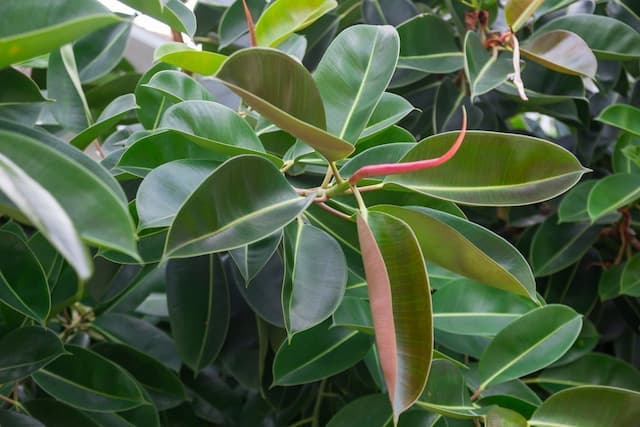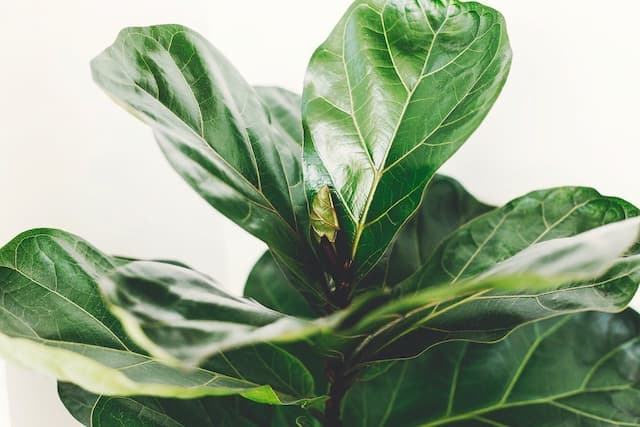Weeping fig Ficus benjamina 'Starlight' (v)

ABOUT
Ficus benjamina 'Starlight' (v), commonly known as the Weeping Fig 'Starlight', is distinguished by its striking variegated foliage. The leaves display a blend of creamy white and shades of green, which can often give them a shimmering appearance as light reflects off the surface. The creamy white often borders the edge of the leaves or appears as irregular spots and blotches within the green. The leaves themselves are glossy, lending a lush and vibrant texture to the plant's overall look. The Weeping Fig 'Starlight' has a graceful growth habit with branches that may arch elegantly under the weight of the leaves. This creates an attractive, flowing canopy that can add an element of sophistication to indoor spaces. The slender branches are flexible and can sometimes be intertwined or braided in cultivated plants for additional decorative appeal. This variety can produce small fruits, but indoors, fruiting is rare. The bark of the plant is smooth and light gray, providing a gentle contrast against the variegated leaves. When grown indoors, the 'Starlight' serves as a lively ornamental addition to any room, bringing in a touch of outdoor elegance with its striking leaf patterns and soft structural form.
About this plant
 Names
NamesFamily
Moraceae
Synonyms
Weeping Fig, Benjamin Fig, Ficus Tree, Variegated Weeping Fig
Common names
Ficus benjamina 'Starlight'
 Toxicity
ToxicityTo humans
The plant commonly known as Weeping Fig is considered to have a low level of toxicity to humans. If ingested, parts of the Weeping Fig can cause digestive discomfort such as stomach pain or vomiting. The plant's sap contains compounds that can irritate the skin and mucous membranes, potentially leading to dermatitis or allergic reactions upon contact.
To pets
Weeping Fig is toxic to pets, such as cats and dogs. If ingested, the plant can cause oral irritation, excessive drooling, and vomiting. The plant's sap can also irritate the skin and mucous membranes, potentially leading to dermatitis or an allergic reaction. Pets that consume any part of the Weeping Fig should be observed closely and might require veterinary care if symptoms worsen.
 Characteristics
CharacteristicsLife cycle
Perennials
Foliage type
Evergreen
Color of leaves
Variegated
Height
6-10 feet (1.8-3 meters)
Spread
3-6 feet (0.9-1.8 meters)
Plant type
Tree
Hardiness zones
10
Native area
Asia
Benefits
 General Benefits
General Benefits- Aesthetic Appeal: The Ficus benjamina 'Starlight' adds visual interest to any indoor or outdoor space with its variegated leaves that have a mix of green and creamy white colors.
- Shade Provider: In outdoor settings, it can grow into a large tree, providing ample shade in gardens and backyards.
- Stress Reduction: Like many indoor plants, it may contribute to reducing stress levels by creating a calming indoor environment.
- Noise Reduction: The dense foliage of this plant can help absorb sound, which aids in reducing background noise levels in indoor settings.
- Humidity Control: It can help maintain humidity levels by releasing water vapor during transpiration, which is particularly beneficial in dry indoor environments.
- Privacy Screen: When planted outdoor or placed indoor in larger pots, its lush foliage can create a natural privacy barrier.
- Feng Shui: It is believed to add positive energy to the home, according to Feng Shui principles, though this isn't universally accepted as a tangible benefit.
- Adaptability: It is relatively adaptable and can adjust to various light conditions, making it suitable for a range of indoor settings.
- Easy Propagation: This plant can be easily propagated from cuttings, allowing for expansion of one's collection or sharing with friends.
- Economic Value: As a popular ornamental, it can add to the economic value in the ornamental nursery trade.
 Medical Properties
Medical PropertiesThis plant is not used for medical purposes.
 Air-purifying Qualities
Air-purifying QualitiesThis plant is not specifically known for air purifying qualities.
 Other Uses
Other Uses- Ficus benjamina 'Starlight' can be used as a source of inspiration for artists and photographers, due to its unique variegated foliage and intricate branching patterns.
- This plant's weeping structure can be applied in interior design to create a feeling of nature indoors, enhancing the aesthetic appeal of a room.
- Its bark and aerial roots can be used in terrariums and fairy gardens for adding texture and a touch of exoticism to miniature landscapes.
- In filmmaking or theatre, the Ficus benjamina 'Starlight' can serve as a natural prop to help set tropical or exotic scenes.
- Used in educational settings, this plant can be a tool for teaching botany and horticulture by illustrating pruning techniques and plant care.
- Ficus benjamina 'Starlight' branches can be crafted into natural frames or wreaths as a base for artistic creations or holiday decorations.
- The leaves can be infused in water to create a natural dye for fabrics, although it's an unusual and experimental use.
- Its interesting shape and form can be a conversation starter in social gatherings or public spaces, promoting community engagement.
- The dense foliage can be used as a subtle screening tool for privacy in gardens or on balconies in urban settings.
- Creative eco-friendly designers may use dried leaves for creating biodegradable jewelry or accessories.
Interesting Facts
 Feng Shui
Feng ShuiThe Weeping Fig is believed to help purify the air and improve indoor environments. It is associated with the wood element and can enhance wealth and career areas when placed in the east or southeast sectors of a home or office.
 Zodiac Sign Compitability
Zodiac Sign CompitabilityThe Weeping Fig is not used in astrology practice.
 Plant Symbolism
Plant Symbolism- Growth and Longevity: Ficus benjamina, commonly known as the Weeping Fig, is a long-living plant representing endurance and the ability to thrive in various conditions, symbolizing personal growth and longevity in human life.
- Flexibility and Adaptability: As the Weeping Fig can adapt to various environments and is quite flexible in terms of care, it symbolizes the need for adaptability and flexibility in life's circumstances.
- Peace and Harmony: Often found in spaces that seek a calming effect, such as offices and homes, the Weeping Fig is associated with peace, tranquility, and the creation of harmonious environments.
- Prosperity: In some cultures, Ficus benjamina is associated with prosperity and is believed to bring positive energy and good luck to the environments where they are placed, reflecting the idea of abundance and well-being.
 Water
WaterThe Weeping Fig should be watered approximately once a week, but this can vary depending on the humidity and temperature of your environment. Make sure the top inch of soil is dry before adding more water. When watering, pour slowly until you see water starting to escape through the drainage holes at the bottom of the pot; this could take around 16 to 32 ounces depending on the size of your plant and pot. Reduce the frequency of watering in the winter months when plant growth typically slows down. Always use room temperature water to avoid shocking the plant's roots.
 Light
LightThe Weeping Fig thrives in bright, indirect light. Place it near a window where it can enjoy plenty of light without being exposed to harsh midday sun. A north or east-facing window is often ideal for providing the kind of light this plant prefers. Avoid placing your Ficus in a spot with insufficient light, as this will lead to poor growth and leaf loss.
 Temperature
TemperatureWeeping Figs prefer temperatures between 65 to 75 degrees Fahrenheit during the day and should not be exposed to temperatures below 60 degrees Fahrenheit, as cold drafts can harm them. The ideal temperature conditions are consistent warmth without fluctuations. Avoid placing your plant near vents or doors that could expose it to sudden changes in temperature.
 Pruning
PruningRegular pruning is not essential for Weeping Figs, but it can help maintain a desired shape and encourage fuller growth. Prune in the late winter or early spring before new growth begins. Remove any dead or damaged branches and trim back any overly long branches to promote a bushier appearance. Always use clean, sharp pruning shears to make clean cuts.
 Cleaning
CleaningAs needed
 Soil
SoilThe Weeping Fig 'Starlight' thrives best in a well-draining soil mix composed of one part peat, one part pine bark, and one part coarse sand or perlite. The recommended soil pH for this plant is slightly acidic to neutral, around pH 6.0-7.0.
 Repotting
RepottingThe Weeping Fig 'Starlight' should generally be repotted every two to three years to replenish its soil and accommodate root growth. Younger plants may require more frequent repotting, while mature ones can be repotted less often.
 Humidity & Misting
Humidity & MistingWeeping Fig 'Starlight' prefers a humidity level between 40-50%. It can tolerate indoor environments but appreciates occasional misting to maintain the recommended humidity range.
 Suitable locations
Suitable locationsIndoor
Place Weeping Fig 'Starlight' in bright, indirect light indoors.
Outdoor
Grow Weeping Fig 'Starlight' in filtered sun or partial shade outside.
Hardiness zone
10-12 USDA
 Life cycle
Life cycleThe life of the 'Starlight' Weeping Fig begins with seed germination, occurring in a warm and moist environment, initiating the growth of the root system and a sprout that will develop into a stem. As a seedling, it develops multiple leaves and begins photosynthesis, gradually maturing into a young plant. With proper care, the juvenile tree grows vigorously, producing its distinctive variegated leaves and beginning to form a woody trunk. Upon reaching maturity, the 'Starlight' Weeping Fig can produce small fruits under ideal indoor conditions, though flowering and fruiting are rare and typically require a specific environment that is often hard to replicate outside of its native habitat. Throughout its life, it will require pruning to maintain shape and size, and it can live for many years as a decorative houseplant. If propagated, cuttings from the plant can develop roots and grow into new plants, thereby continuing the species' cycle.
 Propogation
PropogationPropogation time
Spring-Early Summer
The Ficus benjamina 'Starlight', commonly known as the Weeping Fig, is best propagated through stem cuttings. This method is generally the most successful and popular for indoor gardeners, largely due to its simplicity. The ideal time for taking cuttings is during the spring or early summer, when the plant is in active growth. To propagate, a healthy stem cutting about 4 to 6 inches long (10 to 15 centimeters), with at least a couple of leaves, should be taken from the parent plant. After removing the lower leaves, the cutting can be dipped in a rooting hormone to encourage root growth and then planted in a pot filled with a mix of peat and perlite. The pot should be kept in indirect light and covered with a plastic bag to maintain humidity. Roots typically begin to form within 2 to 4 weeks, after which the cutting can be treated as a new plant.




